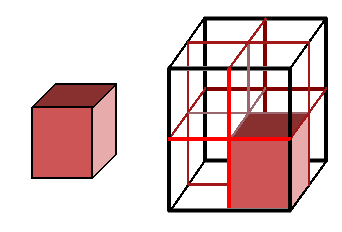|
Why
is the moon red during the lunar eclipse? |
|
|
… because the universe is expanding. The Blue Sky Theory and Entothopter ideas both formed in my mind within the same two minutes. I was now emboldened to ask, simply ‘what other question can I figure out?’ The redness of the moon during an eclipse seemed like a good prospect, especially after the errors of Lord Rayleigh that I had certainly unveiled in the blue sky phenomenon. I searched the web, and it was amusing to find that the official answer was held by Lord Rayleigh. His strange notion was that all interesting color effects must be caused by refraction. (With as much scientific sounding waffle as possible) This time, the theory leads us to believe that refraction causes the red of sunsets; which are supposedly in turn responsible for the redness of the moon during a lunar eclipse. This seemed viable to Lord Rayleigh, despite relatively few sunsets being red. And of course Lord Rayleigh would not have known that this tiny flash of seldom seen red color is not at all visible from space. And the sun is not white. If refraction was responsible, once more we would not see a flat monotone color, but a rainbow. So where was the red coming from? My Science fiction writing research had led me to realize that the majority of nearby stars are red dwarves, too dim to be seen individually by the naked eye. Could they accumulatively cause this redness? It seemed too little, but still much more red light than from the occasional sunset! And it was constant light as well. Never mind that the shape of a circular red ring of light from the Earth’s circumference would produce a ring shape on the moon with an empty center! Not, a smooth monotone crimson color. After much deliberation, it suddenly hit me that the Red Shift (or Doppler Affect) stretches the light from distant galaxies, making the wavelength longer, and therefore: Red. This stretching is due to the universe expanding. In fact it is this observable redness of the Red Shift that leads us to the conclusion that the universe is expanding. But once more, was there enough to make the moon glow? Light
from each star diminishes in magnitude to the inverse of the square
by distance. So that light twice as far away is four times less brilliant.
However the sheer number of celestial bodies in three dimensions of
space increases to the power 3 with distance. |
|
 |
 |
| If
the distance taken into account is doubled, then the number of stars
increases by eight times. Four times less brilliant for each star, but
eight times more stars in total! |
|
|
So
with the amount of light from each star decreasing to the power two,
the sum total of light must be increasing in a perfect straight line.
3-2=1.
How to demonstrate this with an experiment? It is clearly possible to demonstrate that several small lights can accumulate their light to make a big object glow; so that the small lights themselves are not visible. Imagine a fictitious time when the universe consistently contracts for many billions of years. Even though this is most likely not going to happen to this universe, we can still construct a mathematical model of a universe that does actually contract instead of expand. In such a universe, the moon would appear blue during the lunar eclipse. This is because the light would be blue-shifted due to the shorter wavelength caused by the contraction of sspace in a contracting universe. The moon’s color during the lunar eclipse is the ambient color of the surrounding universe. But why do we not see a red light during the solar eclipse? We do, but only when it’s cloudy. I witnessed a cloudy solar eclipse many years ago. I had expected to be disappointed at not being able to see the eclipse due to the overcast conditions. But I looked anyway hoping for a break in the clouds. Everything goes a wonderful crimson color. Slightly orange, but it is mostly red; the same hue of the moon during the corresponding lunar eclipse. Theoretically, it seems that the sun’s corona overpowers the ambient crimson on cloudless solar eclipses. But the cloud somehow blocks the corona leaving the ambient crimson of the surrounding universe. When you consider it empirically, the red moon is the only easily available evidence for the expanding universe. |
|
| Latest
Article: Gravitational Waves & General Relativity |
|
< top >
< seti >
< why? >
< credits >
< contact >
< dark matter >
< dark energy >
< binary orbits >
< the big unwind >
< force of gravity >
< zeno and planck >
< quantum gravity >
< bin laden helicopter crash >
< how the solar system formed >
< why the moon is receding from the earth >
< a full summary of rotation curves of spiral galaxies >
< rubin's problem - rotation curves of galaxies - rubin's problem animated - oscillations in spiral galaxies >


